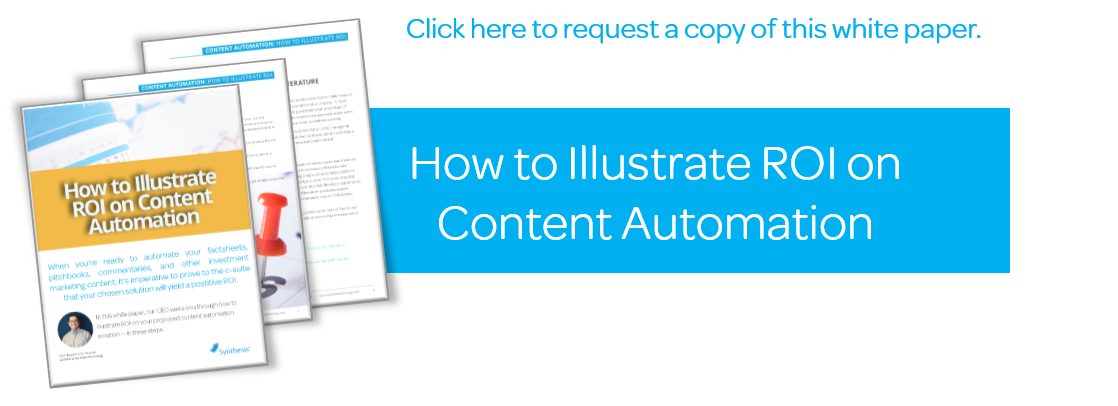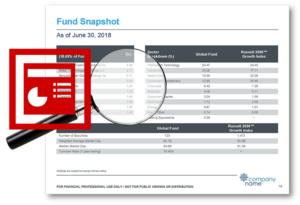3 Factors that Complicate Factsheet Automation

When discussing content automation goals, buzzwords like ‘streamlining’, ‘consistency’, and ‘efficiency’ are often tossed around. These are good goals to strive for but are difficult to achieve due to business reasons beyond marketing’s control. After all, the products represent different strategies, ages, data, and audiences; therefore, the literature has to reflect this. In the end, the main goal of content automation should be to make the process as simple as your firm’s business rules and product nuances will allow.
In a recent content automation report, 23% of asset managers cited producing factsheets monthly. So, the accuracy and timeliness of factsheets are becoming more and more crucial. Yet, this does not necessarily mean less complex. The complexity of your factsheets is one of the main driving factors behind the cost of implementing and maintaining an automated solution. In this blog post, we’ll identify and discuss the top 3 factsheet automation complications:
1. The Number of Template Designs and Varieties
The goal of template design is to keep it simple. That means the less variety between your factsheet templates, the better. Your business rules, component designs, and template layout should stay as consistent as possible across your templates. If variation is necessary, keeping it to a minimum will decrease complexity and keep your implementation costs low. To achieve standardization, look at your documents and identify differences. For each change, ask yourself honestly: Does this really need to be different? Yes, it might be slightly better than the difference you have today, but is that difference really material? Is it selling more products? Is it worth the costs of setup and support for yet another chart or component variation? Flexibility and variability have a cost regardless if you’re in a manual or an automated environment.
A good way to keep variation to a minimum is to reuse components, even if the overall template layout is different from one piece of literature to another. For example, if a firm is using five different top ten holdings tables across the portfolio, we usually work with the client to consolidate them into one or two components that can be used across the board. This exercise can significantly lower cost, complexity, and maintenance.
A good way to keep variation to a minimum is to reuse components, even if the overall template layout is different from one piece of literature to another. For example, if a firm is using five different top ten holdings tables across the portfolio, we usually work with the client to consolidate them into one or two components that can be used across the board. This exercise can significantly lower cost, complexity, and maintenance.
2. Data Complexity
Data that isn’t well-organized or managed in a consistent manner is more difficult to integrate. The complexity of the data files themselves and the number of data sources also factor into the overall complexity of the data setup.
Just like templates, maximizing consistency is the key to lowering the complexity of your data scenario. The more consistent the data source files and formats are, the less complicated the data loading process will be. We find that the most successful automation implementations involve a streamlined data management process whereby a single XML file is sent from the client’s data warehouse with all relevant data. On the other end of the spectrum, firms with dozens of source files in different formats (Excel, XML word, etc), may require load scripts to be written for each. This creates more work and adds to the cost and timeline of the implementation.
The question to ask is, is the data even in your control?
Most of the time, the data scenario is outside of the marketing team’s control. Really, they are at the mercy of their current process. As this is almost always the case, we recommend firms move forward with the automation implementation. Then, work toward streamlining the data piece over time. Firms who wait for that “golden source data” solution usually get stuck waiting two or three years before they can even begin implementing an automated solution. There is a real strategic advantage to forging ahead instead of waiting for that perfect data scenario. The extra costs to wrangle the data in the interim is well worth the investment, as you can immediately start reaping the benefits of a more efficient and cost-effective content production process.
3. The Number of Products, Product Types, and Share Classes
The more products your firm has and the more factsheets your firm produces, the more data and copy mappings, business rules, component variations, and QA are required for automation. Additional data complexity is added when multiple share classes need to be supported per product.
Many firms produce three to four types of documents for each product.
If they are all to be considered for the project, this compounds many elements of automation. That being said, one way asset managers simplify their templates is to consolidate literature types. Do your sales teams really need both Commentaries and Sales Ideas? Maybe yes, maybe no. Efficient firms use analytics to understand actual usage of the materials by the sales teams, as well as by clients. Many asset managers are consolidating content types as a way to contain costs and be more effective. Other firms find great value in addressing each market segment and client persona, so they are expanding their literature set. Both are valid strategies, but these decisions certainly impact operational costs.
As you can see, the complexity of an automation project is driven by several factors. The main question to ask yourself when thinking about automating your factsheets is: How can I simplify and streamline my design, data preparation, and language requirements? The more you can simplify, the more you can contain your costs. We always advise firms to consider the “hidden” costs that are wrapped up in your team’s efforts to simplify these processes in preparation for content automation. This also goes for the internal time and resources you’ll spend on any implementation and ongoing maintenance. Sometimes, it’s better in the long-run to pay the vendor as opposed to getting your personnel involved in complicated automation implementations.
Here are some related resources that might interest you:








 Compare the Top 3 Finserv Content Automation Vendors [White paper]
Compare the Top 3 Finserv Content Automation Vendors [White paper] Create Pitchbooks the Drive Sales [White paper]
Create Pitchbooks the Drive Sales [White paper] Build vs. Buy: Should Your Financial Services Firm Outsource or Insource Marketing Technology? [White paper]
Build vs. Buy: Should Your Financial Services Firm Outsource or Insource Marketing Technology? [White paper]  10 Tips for Rebranding your Fund Marketing Documents [White paper]
10 Tips for Rebranding your Fund Marketing Documents [White paper]



